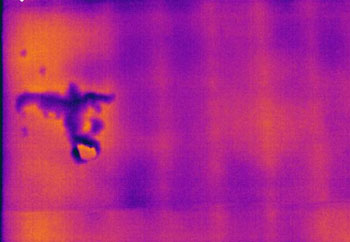Tip of the Week Archive
Detecting Delamination of Stucco
Sponsored by:

Detecting Delamination of Stucco
Tip written by: Infraspection Institute
With aging infrastructure becoming an increasing concern in many communities, more attention is being focused on the maintenance of building facades. Under the right conditions, thermal imaging can detect evidence of delaminated stucco or concrete finishes on the exterior of masonry buildings.
Over time, buildings that utilize concrete stucco for exterior finishes are subject to failure. One of these failures involves the stucco delaminating from its substrate. Delaminated stucco is a serious safety concern as it can cause serious injury to pedestrians should it fall from any significant height.
When concrete stucco delaminates from its substrate, an air pocket is formed between the stucco finish and the substrate. Because this air pocket acts as an insulator, it will change the thermal capacity and/or thermal conductivity in the area of the delamination. Under the correct weather conditions, thermal imaging can detect evidence of delaminated areas.
In order to detect evidence of delaminated areas using thermal imaging, a temperature differential must be present. Typically, infrared inspections of concrete stucco are performed during evening hours following a sunny day. As an alternative, infrared inspections may also be performed during midday under solar loading conditions. Thermal patterns associated with delaminated stucco will generally be amorphous in shape and will typically appear as cold spots during post-sunset inspections or as hot spots during midday inspections.

building facade. Thermogram taken from building exterior
during early evening following a sunny day.
When performing infrared inspections of concrete stucco finishes, keep the following in mind:
- Subject surfaces should be clean and dry
- Wall surfaces must be heated uniformly. Areas in shadow or shade may not produce accurate data
- IR inspections are qualitative in nature. Compare similar areas to each other noting any inexplicable temperature differences
Once the infrared inspection has been completed, all thermal anomalies should be investigated for cause and appropriate corrective measures taken.
Infrared inspection of building envelopes is one of the many topics covered in all Infraspection Institute Level I training courses. For a class schedule or to register for a Distance Learning course, visit Infraspection Institute online or call us at 609-239-4788.
Advertisement

